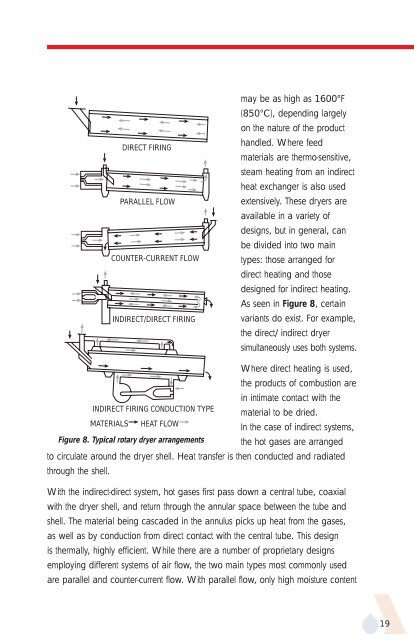APV Dryer Handbook - Umbc
APV Dryer Handbook - Umbc
APV Dryer Handbook - Umbc
Create successful ePaper yourself
Turn your PDF publications into a flip-book with our unique Google optimized e-Paper software.
DIRECT FIRING<br />
PARALLEL FLOW<br />
COUNTER-CURRENT FLOW<br />
INDIRECT/DIRECT FIRING<br />
may be as high as 1600°F<br />
(850°C), depending largely<br />
on the nature of the product<br />
handled. Where feed<br />
materials are thermo-sensitive,<br />
steam heating from an indirect<br />
heat exchanger is also used<br />
extensively. These dryers are<br />
available in a variety of<br />
designs, but in general, can<br />
be divided into two main<br />
types: those arranged for<br />
direct heating and those<br />
designed for indirect heating.<br />
As seen in Figure 8, certain<br />
variants do exist. For example,<br />
the direct/indirect dryer<br />
simultaneously uses both systems.<br />
INDIRECT FIRING CONDUCTION TYPE<br />
Where direct heating is used,<br />
the products of combustion are<br />
in intimate contact with the<br />
material to be dried.<br />
MATERIALS HEAT FLOW<br />
In the case of indirect systems,<br />
Figure 8. Typical rotary dryer arrangements<br />
the hot gases are arranged<br />
to circulate around the dryer shell. Heat transfer is then conducted and radiated<br />
through the shell.<br />
With the indirect-direct system, hot gases first pass down a central tube, coaxial<br />
with the dryer shell, and return through the annular space between the tube and<br />
shell. The material being cascaded in the annulus picks up heat from the gases,<br />
as well as by conduction from direct contact with the central tube. This design<br />
is thermally, highly efficient. While there are a number of proprietary designs<br />
employing different systems of air flow, the two main types most commonly used<br />
are parallel and counter-current flow. With parallel flow, only high moisture content<br />
19











